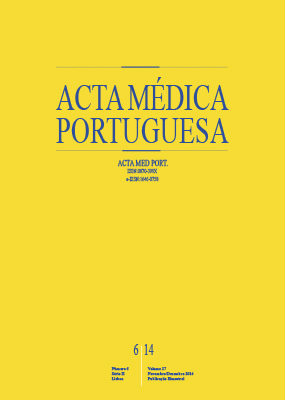Pulmonary Carcinoid: Analysis of a Single Institutional Experience and Prognostic Factors
DOI:
https://doi.org/10.20344/amp.5390Abstract
Introduction: Carcinoid tumors of the lung are rare neoplasms of neuroendocrine origin. According to the World Health Organization, they can be classified into typical carcinoids and atypical carcinoids. The outcome, when compared to other lung neoplasms is usually favorable.Objectives: To characterize the population of patients with a diagnosis of carcinoid tumor, treated in a single institution and analyze the prognostic factors.
Material and Methods: Retrospective analysis including all the patients with histological diagnosis of lung carcinoid tumor during an 11 year period, in a single institution. The tumors were classified according to the World Health Organization classification of carcinoids tumors in 2004. Staging was made according to the TNM classification of 2009 for non-small lung cancer: T (Tumor); N (Node); M (metastasis).
Results: 59 patients were evaluated, including 53 with typical carcinoids and 6 with atypical carcinoid. 90% of the patients were submitted to surgery. The mean follow-up period was 57 months and the early post-operative mortality rate was 2% (one
single case of palliative surgery). Histologic staging showed 49 patients in stage N0, one N1, eight N2 and one N3. The 5-year
survival was 79.2%: 80.2% for typical carcinoids and 66.7% for atypical carcinoid (p < 0.05). The 5-year survival was 88.1%
in T1 patients and 58.2% in T2-T4 patients (p < 0.01). In N0 patients, the 5-year survival was 89.7% while in N1-N3 it was 36% (p < 0.001). The 5-year survival was 85.9% in M0 disease and 0% in M1 disease (p < 0.01). Of the 11 patients who were submitted to adjuvant chemotherapy, 45.4% had atypical tumors.
Discussion: In our sample, surgical treatment was safe, with a low postoperative complication rate. The prognosis was worse for atypical tumors, tumors with more than 3 cm, tumors with nodal involvement or metastasis. The five-year survival for typical carcinoid was excellent (80.2%), in agreement with the literature. For atypical carcinoid, the five-year was 66.7%, also similar to previous studies.
Conclusions: In our institution, most of the lung carcinoids are typical and have an excellent long term survival. The mainstay of treatment is surgical resection. The factors that were related to a poor prognosis were the histological subtype (typical carcinoids versus atypical carcinoids), the size of the tumor, the mediastinal lymphatic involvement and the presence of metastasis.
Keywords: Lung Neoplasms; Carcinoid Tumor; Neoplasm Staging.
Downloads
Downloads
Published
How to Cite
Issue
Section
License
All the articles published in the AMP are open access and comply with the requirements of funding agencies or academic institutions. The AMP is governed by the terms of the Creative Commons ‘Attribution – Non-Commercial Use - (CC-BY-NC)’ license, regarding the use by third parties.
It is the author’s responsibility to obtain approval for the reproduction of figures, tables, etc. from other publications.
Upon acceptance of an article for publication, the authors will be asked to complete the ICMJE “Copyright Liability and Copyright Sharing Statement “(http://www.actamedicaportuguesa.com/info/AMP-NormasPublicacao.pdf) and the “Declaration of Potential Conflicts of Interest” (http:// www.icmje.org/conflicts-of-interest). An e-mail will be sent to the corresponding author to acknowledge receipt of the manuscript.
After publication, the authors are authorised to make their articles available in repositories of their institutions of origin, as long as they always mention where they were published and according to the Creative Commons license.









